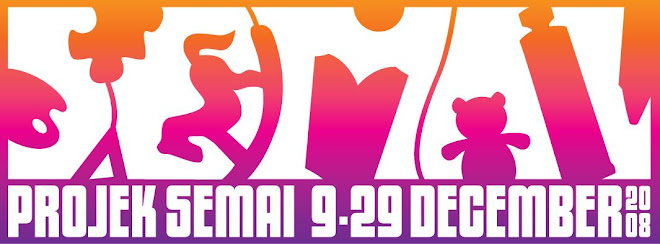Wednesday, January 21, 2009
Exhibition Documentation
Is art important ?

The art around us.

Talking about how other similar projects inspired Semai.
Nice silhouette.

An analysis on the perception of knowledge from the East and the West. Taking into consideration Eastern's and Western's cultural and social background.
Other than telling the concepts of art, we also hoped to convey the message that creativity is an integral tool in education, and how creativity can change the dead-pan, pedantic, scholastic, ontological, meritocratic, study-for-exam-only education system that we have here.

Phoon Shiau Tyng showing some works to one of the visitors.

...with some explainations to assist all the more holistic view on the philosophy of the Puzzle Painting workshop.
Getting busy with the crowds.
Thanks to Choo Ping Hao, David Xavier and Lau Mengq Yek for documenting the entire process. And also for helping out on the presentation.
Thursday, January 15, 2009
Exhibition and Talk
 Public Viewing & Gallery Walkthrough
Public Viewing & Gallery Walkthrough17/1/09 (Saturday) 7pm - 9.30pm
18/1/09 (Sunday) 2pm - 9.30pm
Talk "Why Art?" by Tan Zi Hao (in Mandarin)
17/1/09 (Saturday) 8pm
Venue
11, Jalan BS 5/2, Taman Bukit Serdang, 43300 Seri Kembangan, Selangor Darul Ehsan (map below)

(click to enlarge)
Contact
Tan Zi Hao 017-2604739
Phoon Shiau Tyng 012-3468102
projeksemai@gmail.com
*Do note that the talk will only be in Mandarin. For those who do not understand Mandarin may come on Sunday for gallery walkthrough.
Thursday, January 1, 2009
Day 18
Date: 29 December 2008
Time: 10-11am
Participants: Chin Yi Ton, Hee Li Jie, Lai Shu Wei, Lai Wei Shen, Lim Jun Hong, Saw Khe Xin, Wong Kah Lok, Wong Kai Wei, Annabelle Yap Li Xing
Details: Documenting Mistakes will train the participants to accept mistakes, to see it as an opportunity to learn, to see it as part of the overall documentation of the art like in Jackson Pollock's paintings or to see it as part of the art itself. This helps not just in specifically art subject, but also in real life - to shape a positive independent attitude towards conflicts, failures and mistakes.
---
This workshop started with fury - action painting!Here's the definition of action painting from wiki: Action painting, sometimes called "gestural abstraction", is a style of painting in which paint is spontaneously dribbled, splashed or smeared onto the canvas, rather than being carefully applied. The resulting work often emphasizes the physical act of painting itself as an essential aspect of the finished work or concern of its artist.

Do you agree that everybody has the potential to be an artist?
I don't know if you would appreciate such chaotic artwork, the main idea isn't the aesthetic but the documentation of their movements and strength. It is a painting of event. And this is action painting.
Kai Wei in red, preoccupied with the act of 'throwing' paint...it was a rare opportunity to do so even for me. Unless you have a studio, else who wants to clean up the mess.
A group activity.
Lai Shu Wei (center) did some interesting strokes and splatters. She is the eldest amongst all, maybe she did consider the aesthetic value of the work. But Wong Kah Lok (left) being too excited, kept sweeping the board with brush and pouring water, flattened all the previous actions. And that was part of the documentation too, constantly overlapping each other.
Creating a mess within 15 minutes (which at the end took me 30 minutes to clean up), I hastily rushed them into another room to continue other exercises when the time allocated for action painting ended.
As you can see the pictures from this previous post, I asked them to draw many things which I hoped would have them realize themselves the importance of making 'mistakes'. The idea of this workshop, first is to realize mistake as an opportunity to improve, second, that mistake/imperfection shows individuality that of unique value (the participants were asked to draw a line and a square; a set with ruler, a set without), third, to accept mistake and manipulate it into something of value - see mistakes as something inspiring.
A London based designer Anna Gerber published a book entitled All Messed Up: Unpredictable Graphics where she asked simple questions like 'what is mistake' and 'what is accident'. Putting us into such irony, it actually made us realize how creativity can be explored even through such a subconscious act in which we deemed negative and perceived as error.
All of those actually lead to one single notion - perceive conflicts, failures, mistakes positively. Somehow I believed it has become an Oriental cultural value that we have to avoid problems, being non-confrontational. I truly hoped such exercises of accepting mistake can create some radicals, best done through art education. You think?
Oh, this was the last workshop!










